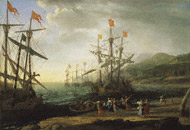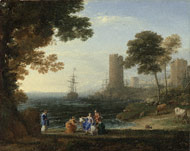|
Two landscapes by Claude Lorrain (Claude Gellée)—one newly acquired by the J. Paul Getty Museum and one on loan from the Metropolitan Museum of Art in New York—are on view together in the Getty Center's East Pavilion, Gallery 202, through early May 2008.
Claude Lorrain was the most famous and influential landscape painter of the 17th century. His refined landscapes were judged by contemporaries to surpass the order, harmony, and beauty of nature itself. A keen observer of nature, Claude undertook regular sketching trips in the Roman countryside with friends such as Nicolas Poussin. His innovative use of light and atmospheric effects and his meticulously composed scenes created a captivating vision of an idealized antique past.
|
|
Both landscapes in the installation represent ambitious historical subjects from ancient Roman poetry.
In Coast View with the Abduction of Europa, the cool light of the rising sun captures the poetic spirit of Jupiter's seduction of Europa as told by the Roman poet Ovid in his Metamorphoses.
Disguised as a magnificent white bull, Jupiter charmed the princess with his docility until she sat demurely on his back, allowing him to whisk her away as his captive. Claude depicts Jupiter rising from his repose as Europa's four attendants adorn the pair with wreaths and flowers.
|
 |

 |
 |
The Trojan Women Setting Fire to Their Fleet, Claude Lorrain, about 1643. The Metropolitan Museum of Art, Fletcher Fund, 1955
|
 |
In The Trojan Women Setting Fire to Their Fleet, Claude portrays an episode from Virgil's Aeneid in which the Trojan women set fire to their fleet to end years of wandering after the fall of Troy. Rain, which will save all but four of the ships, approaches from the right. The sweeping seascape and the impressively decorated galleons with minutely described rigging attest to Claude's intensive exploration of maritime themes in the 1640s.
This landscape has been generously lent to the Getty in exchange for the exceptional loan of Landscape with a Calm by Nicolas Poussin—the other great pioneer of French landscape painting—to the Metropolitan Museum of Art for the exhibition Poussin and Nature: Arcadian Visions.
|


